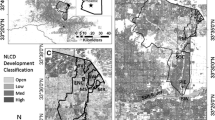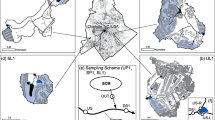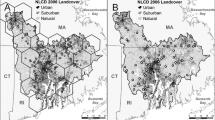Abstract
Watershed urbanization increases the concentrations of major ions in downstream freshwater ecosystems. Non-point source ions from human activities and the chemical weathering of infrastructure are efficiently transported by stormwater runoff through subsurface pipes directly into streams. While the increase in mean streamwater solute concentrations in urban watersheds because of non-point source loading is a commonly documented phenomenon, the temporal dynamics of urban streamwater solute chemistry and its relationship to development patterns is less well understood. We continuously monitored streamflow, temperature, and conductivity as well as bimonthly variation in the solute chemistry of 24 watershed outlets in the Raleigh-Durham-Chapel Hill metropolitan area in North Carolina, USA for two years. Watersheds were selected to have similar proportions of development (10–36% development) while spanning the full measured range in road and stormwater pipe density for urban watersheds in this metropolitan area. We found remarkable temporal variation in the chemical regimes of the urban streams draining this set of watersheds, despite their similar proportion of development. For multiple major ions (SO42−, Cl−, NO3−), bimonthly concentrations varied tenfold across the study streams and temporal variation in streamwater chemical composition increased across watershed road and stormwater pipe density gradients. Total temporal variation in baseflow and stormflow dissolved ions, as measured by the coefficient of variation of specific conductance, was highly correlated with road density after accounting for underlying geology (R2 > 0.60). Using structural equation modeling, we found that subsurface piping mediates the relationship between roads and stream chemistry. In watersheds with high stormwater pipe density, streamwater ionic strength was low at baseflow while high and highly variable during event flow. This ‘flashy’ chemical signal in those watersheds, mirrors their more responsive hydrographs. In contrast, in our urban watersheds with the lowest pipe density, baseflow ionic strengths were higher, and event flow ionic strengths were lower and less variable. These results suggest that the extent to which pavement is drained by pipes creates a tradeoff between routing urban salts directly to streams via pipes versus indirectly to streams via loading to groundwater. Results of this study demonstrate the importance of considering altered temporal chemical variability, not just elevated solute concentrations, as a key feature of the impact of urbanization on streams. Future urban development design which minimizes the extent of roads and stormwater pipes in watersheds through denser development may be an effective strategy to abate impacts on downstream water quality.





Similar content being viewed by others
References
Alberti M, Booth D, Hill K et al (2007) The impact of urban patterns on aquatic ecosystems: an empirical analysis in Puget lowland sub-basins. Landsc Urban Plan 80:345–361. https://doi.org/10.1016/j.landurbplan.2006.08.001
Bach PM, McCarthy DT, Deletic A (2010) Redefining the stormwater first flush phenomenon. Water Res 44:2487–2498. https://doi.org/10.1016/j.watres.2010.01.022
Baker DB, Richards RP, Loftus TT, Kramer JW (2004) A new flashiness index: characteristics and applications to midwestern rivers and streams. J Am Water Resour Assoc 40:503–522. https://doi.org/10.1111/j.1752-1688.2004.tb01046.x
Baker LA, Hartzheim PM, Hobbie SE et al (2007) Effect of consumption choices on fluxes of carbon, nitrogen and phosphorus through households. Urban Ecosyst 10:97–117. https://doi.org/10.1007/s11252-006-0014-3
Baruch EM, Voss KA, Blaszczak JR et al (2018) Not all pavements lead to streams: variation in impervious surface connectivity affects urban stream ecosystems. Freshw Sci 37:673–684. https://doi.org/10.1086/699014
Bender EA, Case TJ, Gilpin ME (1984) Peturbation experiments in community ecology: theory and practice. Ecology 65:1–13
Bernhardt ES, Band LE, Walsh CJ, Berke PE (2008) Understanding, managing, and minimizing urban impacts on surface water nitrogen loading. Ann N Y Acad Sci 1134:61–96. https://doi.org/10.1196/annals.1439.014
Blaszczak JR, Delesantro JM, Urban DL et al (2018) Scoured or suffocated: urban stream ecosystems oscillate between hydrologic and dissolved oxygen extremes. Limnol Oceanogr. https://doi.org/10.1002/lno.11081
Booth DB, Jackson CR (1997) Urbanization of aquatic systems: degradation thresholds, stormwater detection, and the limits of mitigation. J Am Water Resour Assoc 33:1077–1090. https://doi.org/10.1111/j.1752-1688.1997.tb04126.x
Bratt AR, Finlay JC, Hobbie SE et al (2017) Contribution of leaf litter to nutrient export during winter months in an urban residential watershed. Environ Sci Technol 51:3138–3147. https://doi.org/10.1021/acs.est.6b06299
Cadenasso ML, Pickett STA, Schwarz K (2007) Spatial heterogeneity in urban ecosystems: conceptualizing land cover and a framework for classification. Front Ecol Environ 5:80–88. https://doi.org/10.1890/1540-9295(2007)5%5b80:SHIUER%5d2.0.CO;2
Carle MV, Halpin PN, Stow CA (2005) Patterns of watershed urbanization and impacts on water quality. J Am Water Resour Assoc 41:693–708. https://doi.org/10.1111/j.1752-1688.2005.tb03764.x
Chambers LG, Chin YP, Filippelli GM et al (2016) Developing the scientific framework for urban geochemistry. Appl Geochem 67:1–20. https://doi.org/10.1016/j.apgeochem.2016.01.005
City of Carrboro (2005) Carrboro GIS features: stormwater data
City of Durham (2010a) Stormwater and GIS Services: Impervious areas, paved areas
City of Durham (2010b) Stormwater and GIS Services: stormwater data
City of Raleigh Public Works (2014) Raleigh GIS features: stormwater data
Connor NP, Sarraino S, Frantz DE, Bushaw-Newton K, MacAvoy SE (2014) Geochemical characteristics of an urban river: influences of an anthropogenic landscape. Appl Geochem 47:209–216
Cuffney TF, Brightbill RA, May JT, Waite IR (2010) Responses of benthic macroinvertebrates to environmental changes associated with urbanization in nine metropolitan areas. Ecol Appl 20:1384–1401. https://doi.org/10.1890/08-1311.1
Divers MT, Elliott EM, Bain DJ (2013) Constraining nitrogen inputs to urban streams from leaking sewers using inverse modeling: implications for dissolved inorganic nitrogen (DIN) retention in urban environments. Environ Sci Technol 47:1816–1823. https://doi.org/10.1021/es304331m
Duncan JM, Welty C, Kemper JT et al (2017) Dynamics of nitrate concentration-discharge patterns in an urban watershed. Water Resour Res 53:7349–7365. https://doi.org/10.1002/2017WR020500
Easton ZM, Gérard-Marchant P, Walter MT et al (2007) Hydrologic assessment of an urban variable source watershed in the northeast United States. Water Resour Res 43:1–18. https://doi.org/10.1029/2006WR005076
Fork ML, Blaszczak JR, Delesantro JM, Heffernan JB (2018) Engineered headwaters can act as sources of dissolved organic matter and nitrogen to urban stream networks. Limnol Oceanogr Lett. https://doi.org/10.1002/lol2.10066
Fry JA, Xian G, Jin S et al (2011) Completion of the 2006 National Land Cover Database for the conterminous United States. Photogramm Eng Remote Sens 77:858–866
Gallo EL, Brooks PD, Lohse KA, McLain JET (2013) Land cover controls on summer discharge and runoff solution chemistry of semi-arid urban catchments. J Hydrol 485:37–53. https://doi.org/10.1016/j.jhydrol.2012.11.054
Gardner RH, Urban DL (2007) Neutral models for testing landscape hypotheses. Landsc Ecol 22:15–29. https://doi.org/10.1007/s10980-006-9011-4
Garizi AZ, Sheikh V, Sadoddin A (2011) Assessment of seasonal variations of chemical characteristics in surface water using multivariate statistical methods. Int J Environ Sci Technol 8:581–592. https://doi.org/10.1007/BF03326244
Gobel P, Dierkes C, Coldewey WG (2007) Stormwater runoff concentration matrix for urban areas. J Contam Hydrol 91:26–42
Grace JB, Schoolmaster DR, Guntenspergen GR et al (2012) Guidelines for a graph-theoretic implementation of structural equation modeling. Ecosphere. https://doi.org/10.1890/es12-00048.1
Griffith GE, Omernik JM, Cornstock J, et al (2002) Ecoregions of North Carolina. 97333
Groffman PM, Law NL, Belt KT et al (2004) Nitrogen fluxes and retention in urban watershed ecosystems. Ecosystems 7:393–403. https://doi.org/10.1007/s10021-003-0039-x
Hale RL, Turnbull L, Earl SR et al (2014) Stormwater infrastructure controls runoff and dissolved material export from arid urban watersheds. Ecosystems 18:62–75. https://doi.org/10.1007/s10021-014-9812-2
Haq S, Kaushal SS, Duan S (2018) Episodic salinization and freshwater salinization syndrome mobilize base cations, carbon, and nutrients to streams across urban regions. Biogeochemistry 2:1. https://doi.org/10.1007/s10533-018-0514-2
Hassett BA, Sudduth EB, Somers KA et al (2018) Pulling apart the urbanization axis: patterns of physiochemical degradation and biological response across stream ecosystems. Freshw Sci 37:653–672. https://doi.org/10.1086/699387
Hatt BE, Fletcher TD, Walsh CJ, Taylor SL (2004) The influence of urban density and drainage infrastructure on the concentrations and loads of pollutants in small streams. Environ Manage 34:112–124. https://doi.org/10.1007/s00267-004-0221-8
Hewlett JD, Hibbert AR (1967) Factors affecting the response of small watersheds to precipitation in humid areas. For Hydrol 1:275–290
Hobbie SE, Finlay JC, Janke BD et al (2017) Contrasting nitrogen and phosphorus budgets in urban watersheds and implications for managing urban water pollution. Proc Natl Acad Sci. https://doi.org/10.1073/pnas.1618536114
Holmes RM, Aminot A, Kérouel R et al (1999) A simple and precise method for measuring ammonium in marine and freshwater ecosystems. Can J Fish Aquat Sci 56:1801–1808. https://doi.org/10.1139/f99-128
Homer CG, Dewitz JA, Yang L et al (2015) Completion of the 2011 National Land Cover Database for the conterminous United States-representing a decade of land cover change information. Photogramm Eng Remote Sens 81:345–354
Hopkins KG, Morse NB, Bain DJ et al (2015) Assessment of regional variation in streamflow responses to urbanization and the persistence of physiography. Environ Sci Technol 49:2724–2732. https://doi.org/10.1021/es505389y
Horowitz AJ, Stephens VC (2008) The effects of land use on fluvial sediment chemistry for the conterminous U.S.—results from the first cycle of the NAWQA program: trace and major elements, phosphorus, carbon, and sulfur. Sci Total Environ 400:290–314. https://doi.org/10.1016/j.scitotenv.2008.04.027
Jacob JS, Lopez R (2009) Is denser greener? an evaluation of higher density development as an urban stormwater-quality best management practice. J Am Water Resour Assoc 45:687–701. https://doi.org/10.1111/j.1752-1688.2009.00316.x
Janke BD, Finlay JC, Hobbie SE et al (2013) Contrasting influences of stormflow and baseflow pathways on nitrogen and phosphorus export from an urban watershed. Biogeochemistry. https://doi.org/10.1007/s10533-013-9926-1
Jones KB, Neale AC, Nash MS et al (2001) Predicting nutrient and sediment loadings to streams from landscape metrics: a multiple watershed study from the United States Mid-Atlantic Region. Landsc Ecol 16:301–312. https://doi.org/10.1023/A:1011175013278
Kaushal SS, Belt KT (2012) The urban watershed continuum: evolving spatial and temporal dimensions. Urban Ecosyst 15:409–435. https://doi.org/10.1007/s11252-012-0226-7
Kaushal SS, Groffman PM, Band LE et al (2011) Tracking nonpoint source nitrogen pollution in human-impacted watersheds. Environ Sci Technol 45:8225–8232. https://doi.org/10.1021/es200779e
Kaushal SS, Delaney-Newcomb K, Findlay SEG et al (2014a) Longitudinal patterns in carbon and nitrogen fluxes and stream metabolism along an urban watershed continuum. Biogeochemistry 121:23–44. https://doi.org/10.1007/s10533-014-9979-9
Kaushal SS, McDowell WH, Wollheim WM (2014b) Tracking evolution of urban biogeochemical cycles: past, present, and future. Biogeochemistry 121:1–21. https://doi.org/10.1007/s10533-014-0014-y
Kaushal SS, Duan S, Doody TR et al (2017) Human-accelerated weathering increases salinization, major ions, and alkalinization in fresh water across land use. Appl Geochemistry 83:121–135. https://doi.org/10.1016/j.apgeochem.2017.02.006
Kaushal SS, Gold AJ, Bernal S et al (2018a) Watershed ‘chemical cocktails’: forming novel elemental combinations in Anthropocene fresh waters. Biogeochemistry. https://doi.org/10.1007/s10533-018-0502-6
Kaushal SS, Likens GE, Pace ML et al (2018b) Freshwater salinization syndrome on a continental scale. Proc Natl Acad Sci. https://doi.org/10.1073/pnas.1711234115
Kaye JP, Groffman PM, Grimm NB et al (2006) A distinct urban biogeochemistry? Trends Ecol Evol 21:192–199. https://doi.org/10.1016/j.tree.2005.12.006
Keitt TH, Urban DL, Milne BT (1997) Detecting critical scales in fragmented landscapes. Conserv Ecol. https://doi.org/10.5751/es-00015-010104
Kirchmann H, Pettersson S (1994) Human urine—chemical composition and fertilizer use efficiency. Fertil Res 40:149–154. https://doi.org/10.1007/BF00750100
Leopold L (1968) Hydrology for urban land planning—a guidebook on the hydrologic effects of urban land use. Geol Surv Circ 554:1–21. https://doi.org/10.1017/CBO9781107415324.004
Liu A, Goonetilleke A, Egodawatta P (2012) Inadequacy of land use and impervious area fraction for determining urban stormwater quality. Water Resour Manag 26:2259–2265. https://doi.org/10.1007/s11269-012-0014-4
Makepeace DK (1995) Urban stormwater quality—summary of contaminant data. Crit Rev Environ Sci Technol 25:93–139
McDonald RI, Urban DL (2006) Spatially varying rules of landscape change: lessons from a case study. Landsc Urban Plan 74:7–20. https://doi.org/10.1016/j.landurbplan.2004.08.005
McGarigal K, Cushman SA, Ene E (2012) FRAGSTATS v4: spatial pattern analysis program for categorical and continuous maps
Miles B, Band LE (2015) Green infrastructure stormwater management at the watershed scale: urban variable source area and watershed capacitance. Hydrol Process 29:2268–2274. https://doi.org/10.1002/hyp.10448
Moore J, Bird DL, Dobbis SK, Woodward G (2017) Nonpoint source contributions drive elevated major ion and dissolved inorganic carbon concentrations in urban watersheds. Environ Sci Technol Lett 4:198–204. https://doi.org/10.1021/acs.estlett.7b00096
Mulholland PJ (2008) Stream denitrification across biomes and its response to anthropogenic nitrate loading. Nature. https://doi.org/10.1038/nature06686
NCDOT (North Carolina Department of Transportation) (2015) NCDOT Data GIS Layers. https://connect.ncdot.gov/resources/gis/pages/gis-data-layers.aspx)
Oswald CJ, Giberson G, Nicholls E et al (2019) Spatial distribution and extent of urban land cover control watershed-scale chloride retention. Sci Total Environ 652:278–288. https://doi.org/10.1016/j.scitotenv.2018.10.242
Parr TB, Smucker NJ, Neale MW, Bentsen CN (2016) Potential roles of past, present, and future urbanization characteristics in producing varied stream responses. Freshw Sci 35:436–443. https://doi.org/10.1086/685030
Paul MJ, Meyer J (2001) Streams in the urban landscape. Annu Rev Ecol Syst 32:333–365
Pennino MJ, Kaushal SS, Mayer PM et al (2016) Stream restoration and sewers impact sources and fluxes of water, carbon, and nutrients in urban watersheds. Hydrol Earth Syst Sci 20:3419–3439. https://doi.org/10.5194/hess-20-3419-2016
Pickett STA, Cadenasso ML, Rosi-Marshall EJ et al (2016) Dynamic heterogeneity: a framework to promote ecological integration and hypothesis generation in urban systems. Urban Ecosyst. https://doi.org/10.1007/s11252-016-0574-9
R Core Team (2017) R: a language and environment for statistical computing. R Core Team, Vienna
Ramírez A, Rosas KG, Luago AE, Ramos-González OM (2014) Spatio-temporal variation in stream water chemistry in a tropical urban watershed. Ecol Soc 19:45. https://doi.org/10.5751/ES-06481-190245
Redman CL, Jones NS (2005) The environmental, social, and health dimensions of urban expansion. Popul Environ 26:505–520. https://doi.org/10.1007/s11111-005-0010-1
Reisinger AJ, Woytowitz E, Majcher E et al (2018) Changes in long-term water quality of Baltimore streams are associated with both gray and green infrastructure. Limnol Oceanogr. https://doi.org/10.1002/lno.10947
Rose S (2007) The effects of urbanization on the hydrochemistry of base flow within the Chattahoochee River Basin (Georgia, USA). J Hydrol 341:42–54. https://doi.org/10.1016/j.jhydrol.2007.04.019
Rosseel Y (2012) Lavaan: an R package for structural equation modeling. J Stat Softw 48:1–36
Seto KC, Guneralp B, Hutyra LR (2012) Global forecasts of urban expansion to 2030 and direct impacts on biodiversity and carbon pools. Proc Natl Acad Sci 109:16083–16088. https://doi.org/10.1073/pnas.1211658109
Sexton JO, Urban DL, Donohue MJ, Song C (2013) Long-term land cover dynamics by multi-temporal classification across the Landsat-5 record. Remote Sens Environ 128:246–258. https://doi.org/10.1016/j.rse.2012.10.010
Shields CA, Band LE, Law N et al (2008) Streamflow distribution of non-point source nitrogen export from urban-rural catchments in the Chesapeake Bay watershed. Water Resour Res 44:1–13. https://doi.org/10.1029/2007WR006360
Smith ML, Zhou W, Cadenasso M et al (2010) Evaluation of the national land cover database for hydrologic applications in urban and suburban Baltimore, Maryland. J Am Water Resour Assoc 46:429–442
Snodgrass JW, Moore J, Lev SM et al (2017) Influence of modern stormwater management practices on transport of road salt to surface waters. Environ Sci Technol 51:4165–4172. https://doi.org/10.1021/acs.est.6b03107
Somers KA, Bernhardt ES, Grace JB et al (2013) Streams in the urban heat island: spatial and temporal variability in temperature. Freshw Sci 32:309–326. https://doi.org/10.1899/12-046.1
Somers KA, Bernhardt ES, McGlynn BL, Urban DL (2016) Downstream dissipation of storm flow heat pulses: a case study and its landscape-level implications. J Am Water Resour Assoc 52:281–297. https://doi.org/10.1111/1752-1688.12382
Taverna K, Urban DL, McDonald RI (2005) Modeling landscape vegetation pattern in response to historic land-use: a hypothesis-driven approach for the North Carolina Piedmont, USA. Landsc Ecol 20:689–702. https://doi.org/10.1007/s10980-004-5652-3
Town of Chapel Hill (2003) Chapel Hill GIS features: Planimetrics
Town of Chapel Hill (2010) Chapel Hill GIS features: stormwater data
UNEP GEMS (2008) Water quality for ecosystem and human health, 2nd edn. UNEP GEMS, Nairobi
Utz RM, Hopkins KG, Beesley L et al (2016) Ecological resistance in urban streams: the role of natural and legacy attributes. Freshw Sci 35:380–397. https://doi.org/10.1086/684839
Wake County Government (2013) City of Raleigh Planimetrics. http://www.wakegov.com/gis/services/Pages/data.aspx. Accessed 8 Aug 2015
Walsh CJ, Roy AH, Feminella JW et al (2005) The urban stream syndrome: current knowledge and the search for a cure. J N Am Benthol Soc 24:706–723
Wenger SJ, Roy AH, Jackson CR et al (2009) Twenty-six key research questions in urban stream ecology: an assessment of the state of the science. J North Am Benthol Soc 28:1080–1098. https://doi.org/10.1899/08-186.1
Xian G, Homer C, Dewitz J et al (2011) Change of impervious surface area between 2001 and 2006 in the conterminous United States. Photogramm Eng Remote Sens 77:754–762
Yang YY, Toor GS (2017) Sources and mechanisms of nitrate and orthophosphate transport in urban stormwater runoff from residential catchments. Water Res 112:176–184. https://doi.org/10.1016/j.watres.2017.01.039
Acknowledgements
Thank you to Brooke Hassett, Erin Vanderjeugdt, Lillian McGill, Ethan Baruch, Megan Fork, Eric Moore, Steve Anderson, Zane Anthony, Brynn O’Donnell, Theo Tran, Sarah Sargent, Mikia Weidenbach, Jennifer Brennan, and Christina Davis for field and lab assistance. Thank you to the Bernhardt lab and Duke River Center for helpful comments on early drafts of this manuscript. Thank you to the anonymous reviewers for their comments which improved the manuscript. This research was supported by grants from the National Science Foundation’s Division of Environmental Biology (DEB-1258017) and by the National Science Foundation Graduate Research Fellowship (GDE-1644868). Any opinions, findings, and conclusions or recommendations expressed in this material are those of the authors and do not necessarily reflect the views of the National Science Foundation.
Author information
Authors and Affiliations
Corresponding author
Additional information
Publisher's Note
Springer Nature remains neutral with regard to jurisdictional claims in published maps and institutional affiliations.
Responsible Editor: J. M. Melack.
Electronic supplementary material
Below is the link to the electronic supplementary material.
Rights and permissions
About this article
Cite this article
Blaszczak, J.R., Delesantro, J.M., Zhong, Y. et al. Watershed urban development controls on urban streamwater chemistry variability. Biogeochemistry 144, 61–84 (2019). https://doi.org/10.1007/s10533-019-00572-7
Received:
Accepted:
Published:
Issue Date:
DOI: https://doi.org/10.1007/s10533-019-00572-7




